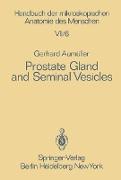- Start
- Prostate Gland and Seminal Vesicles
Prostate Gland and Seminal Vesicles
Angebote / Angebote:
When STIEVE published his work on male reproductive organs in this handbook in 1930, a definitive treatment of the morphology of the accessory sex glands seemed accomplished. Nevertheless, the increasing bulk of scientific literature published in the last years on this topic has demonstrated that new methods, e. g. , developments in the fields of electron microscopy, cytochemistry and auto radiography, pose new questions. These principally morphological techniques have yielded new insights into the fine structure and functional organization of these glands. The stress, however, lay on biochemical questions concerning the mechanism of hormone action, since the accessory sex glands were considered to be primary target organs of hormone action, i. e. , their cells bind specific hormones. Besides the basic interest of endocrinologists, morphologists, and biochemists, several unanswered questions arose from the practitioners, e. g. , urologists, andrologists, and other clinicians, especially as regards the prostate gland, one of the organs most affected in elderly men. Thus, the epidemiologic investigations of the last years proved this very organ to be one of the most frequent causes of death in elderly men (HANSEN, 1977). The view of the practi tioner established a special field of investigation and effected a shift from morphologic analysis to biochemical or endocrine aspects. Nevertheless, mor phology, if tempered by experimental or concomitant biochemical studies, pro vides a solid base for tracing the pathologic events occurring in these organs.
Folgt in ca. 5 Arbeitstagen
